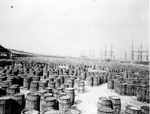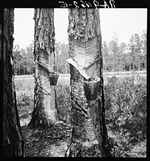Naval Stores
An Early Industry
Naval stores is the collective name for all products made from the gum of the pine tree. Its name refers to the original use of tar as a caulking and waterproofing on ships. In the early 19th century, the United States was entering a period of rapid industrialization. There was an enormous demand for naval stores in this emerging economy.
Uses
Many products were made directly from the pine gum and it was used in the production of
many others. Turpentine alone was used as thinners for paints and varnishes, solvents for waxes in
polishes,
waterproof cements, cleaners to remove paints and oils from fabrics, disinfectants, liniments, medicated
soaps, internal medicines, ointments, synthetic camphor, celluloid, explosives, fire works, synthetic
rubber, glazing putty, printing inks, lubricants for grinding and drilling glass, moth repellents,
insecticides, crayons, patent leather, in petroleum refinement, textile manufacturing, and ore
refinement.
Extraction
The method used in tapping the pine trees caused considerable damage to the tree. A heavily tapped area of pine forest could be depleted and destroyed in 10 years or less. As an area was played out the practitioner was forced to find new forests to exploit. This accounts for much of the land purchased by the first three Hussey generations.
A. J. Baker, who grew up in the Bakers Chapel area of Hoary county, described the practices of the naval stores industry of that time this way:
I was raised on a farm and had every opportunity to observe just what was going on in and around that small farm surrounded by almost a primeval forest where workers of the industry were constantly seen during the summer season. Nearly all of the farms were small and provided only provisions consumed at home. Hence the turpentine industry to bring in a little cash.
The tools used in carrying on the industry were the boxing ax, the hack, the puller, the dipper, the scraper, the bucket, the scrape box, and the barrel. Some of these implements, I know seem foreign to many of the people living today, and I wish I had some of them at least, with me so that I could demonstrate how they were used.
The predominating forest of trees, at that time, was the long leaf pine from which the sap was extracted. A notch or box, as it was called was cut near the ground in the tree, holding about a quart. This was done with a boxing ax. The next tool used was the hack, which was used applying streaks until the face of the tree became about a head high.

Then the streaks were applied by the puller. The streaks were applied weekly during the spring and summer. Usually the streaks would dry out in a weeks time stopping the flow of sap. Then, of course, a new one must be applied to start the sap flow again. When the notch or box mentioned was full of sap or turpentine, as it was called, it was ready to be dipped, put in barrels and hauled to market. This was known as dip turpentine.
During the spring and summer season, the working period, I just mentioned, some of the sap would lodge on the face of the boxed tree. The face I'd better explain, is where the numerous streaks had been made by the hack or by the puller. Since not all of the sap of the tree would reach the box below; some of it would lodge on the face. Here it would harden flake white, lose much of its liquid appearance, and become a sort of dry turpentine. During the summer season, the accumulation of this turpentine amounted to quite an item.
During the fall and winter, this turpentine was scraped from the face of the tree, gathered in suitable boxes, packed in barrels, and was ready for market. This was known as scraped turpentine and gave the workers something to do during the off season. The trees were now again ready for the prime summer season.
After the turpentine was gathered and placed in barrels, it was hauled to market by mule

At the market place, the barreled product was weighed, paid for at a certain price per gage weight . . . whichever gage weight was in force. I never knew just why the gage weight varied.
The next step of the gummy product was the distillation. I was too young and unconcerned to know very much about this process. The barreled turpentine was bought up by the larger merchants who owned the stills. The stills consisted of a large retort with a capacity of several barrels. The retort was built in upon a furnace under which a fire producing a slow heat would drive the spirits into a condensing or cooling system. It was placed in tight non-leaking barrels for shipment to the commission merchants. The residue or rosin was also poured in barrels for shipment.
As is the system today of tenant farming, the land owner would sharecrop his timber land to producers as tenants on a share-crop basis. I think the method varied in different communities. The small landowner would be his own producer, while the large landowner would perhaps have several tenants and producers in common. The tenant usually was allotted a certain number of boxes or pines as a crop, but I do not remember how many composed the allotment.
By the time A.T. Hussey started working in the Naval Stores business in 1908 the practice of cutting a hole or box in the tree to catch the gum had been replaced by metal cups that attached to the tree. This caused much less damage to the tree and allowed the tree to continue producing much longer. Also, A.T. Hussey was much more involved in distilling and manufacturing naval store products rather than the gathering of the pine gum.
